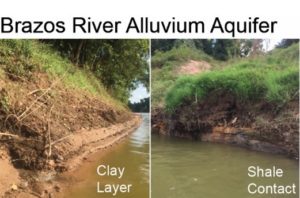
Mehmood, T., Miller, G.R. and Knappett, P.S.K. (2022), Testing alternative conceptual models of river-aquifer connectivity and their impacts on baseflow and river recharge processes. Hydrological Processes, e14545. https://doi.org/10.1002/hyp.14545
This study simulates the dynamics of exchange fluxes between Brazos River Alluvium Aquifer and the Brazos River, TX, USA. Seven conceptual models for the connection between the river and the aquifer were simulated in HYDRUS 2D using small-scale, high-resolution transects across the river. These models assumed varying aquifer lithology and river incision depths and considered processes such as riverbed clogging and seepage face flows. Observed river stage values were used to specify a time-variable head boundary, and the simulations were tested against observed hydraulic heads in two nearby monitoring wells. The nearly 1.5 years of sub-hourly measurements spanned both flood and drought periods. The best-fit conceptual model supported a hypothesized hydraulic disconnection between the subsurface near the river and the wider alluvial aquifer. In contrast to the assumptions of previous studies, these data were more consistent with the presence of a thin, low-K structure (such as an abandoned paleochannel) rather than riverbed clogging. Across the range of models evaluated, the average net exchange between the river and the aquifer ranged from 0.016 to 12.4 m3/d/m. Most of the variability was attributed to baseflow across the riverbed, which ranged from 0.18 to 13.1 m3/d/m depending on the model. The ranges of exchange fluxes across the seepage face (0.004 to 2.37 m3/d/m) and recharge from the river to the aquifer (0.1 to 5.63 m3/d/m) were significant, but not as influential. Based on these values, the choice of conceptual model could have a profound impact on the accuracy of numerical models used for river management. Extrapolated across the entire reach, this uncertainty would amount to ±83 m3/s of discharge, equivalent to 34% of the river’s discharge near its outlet.
